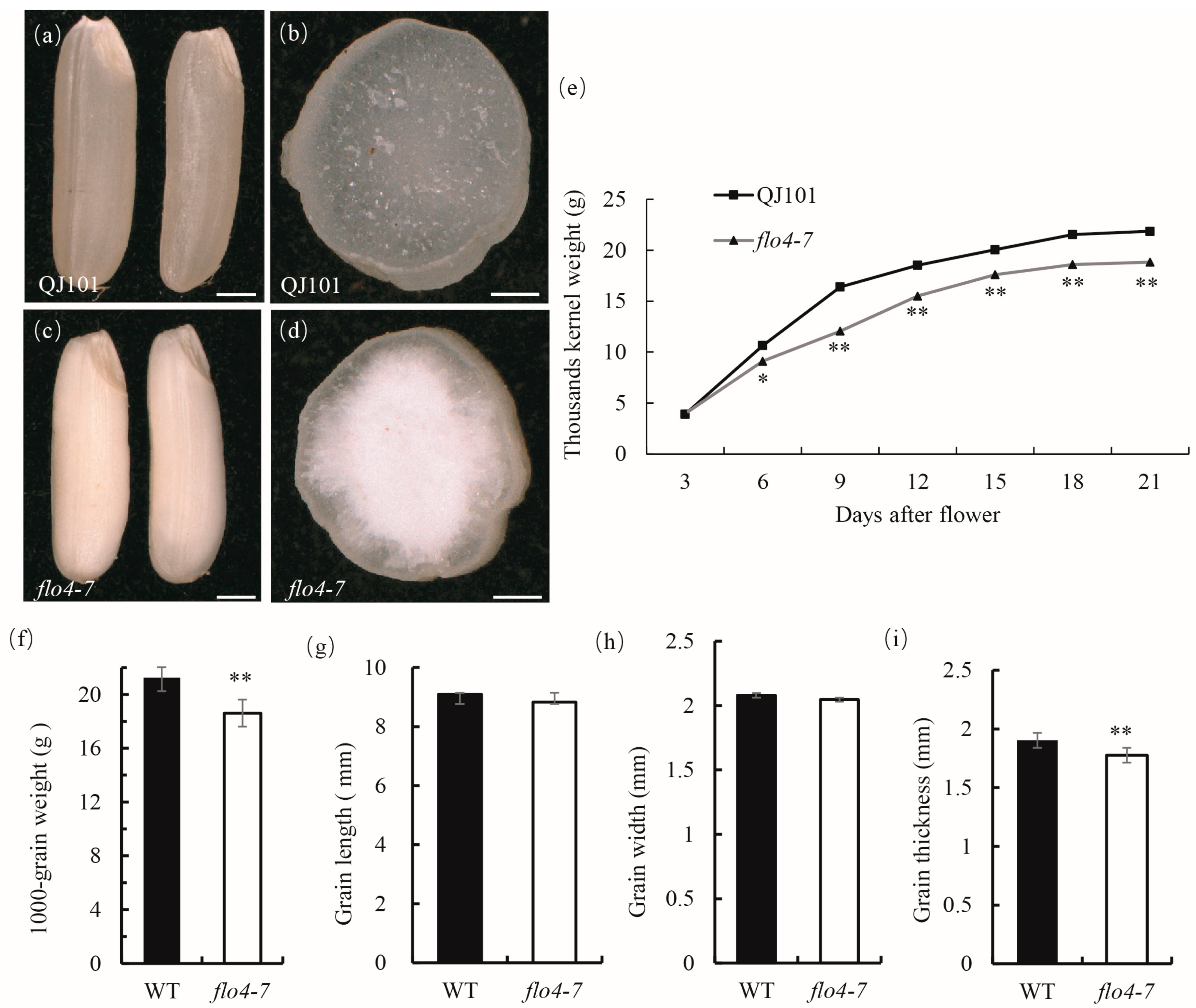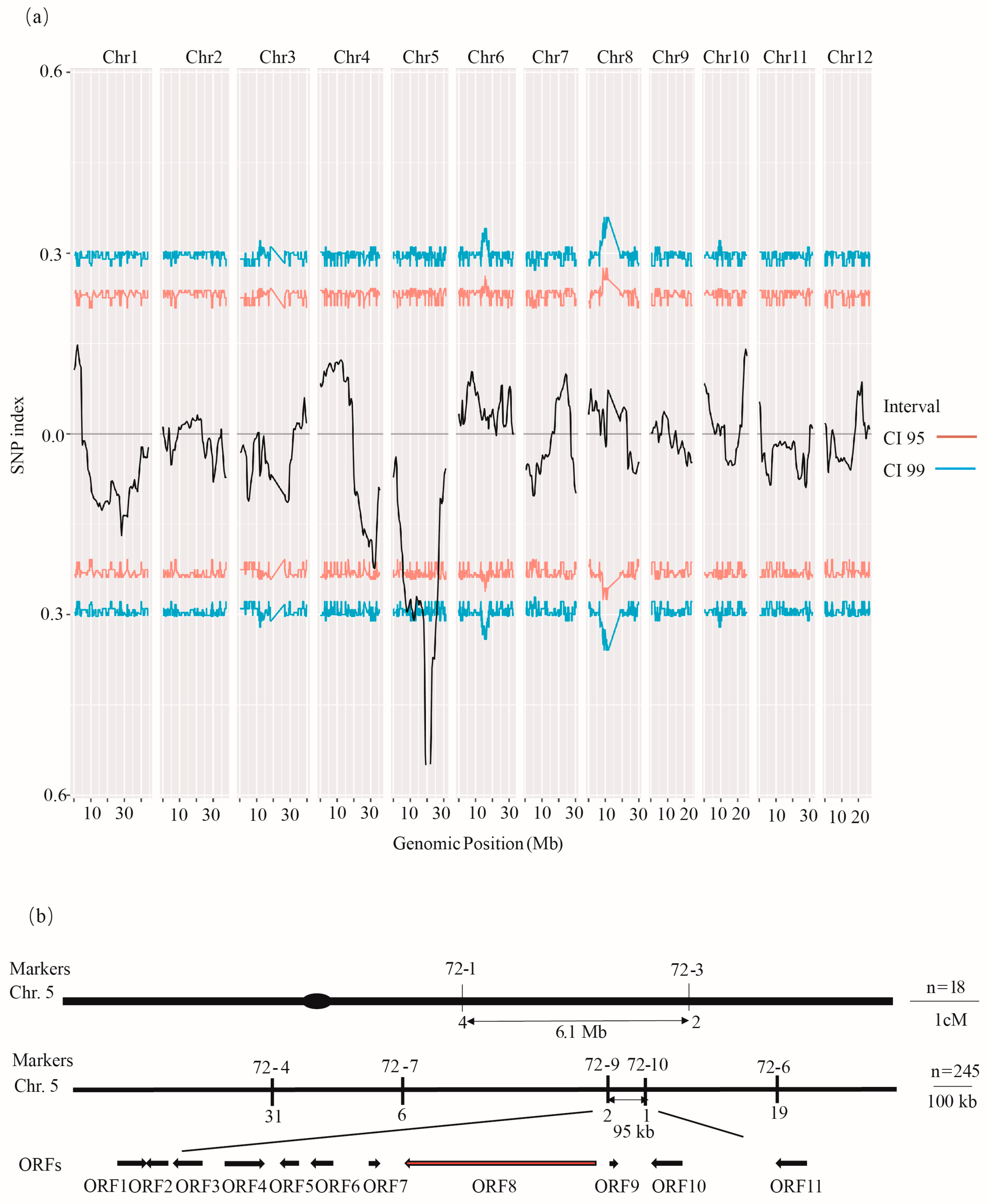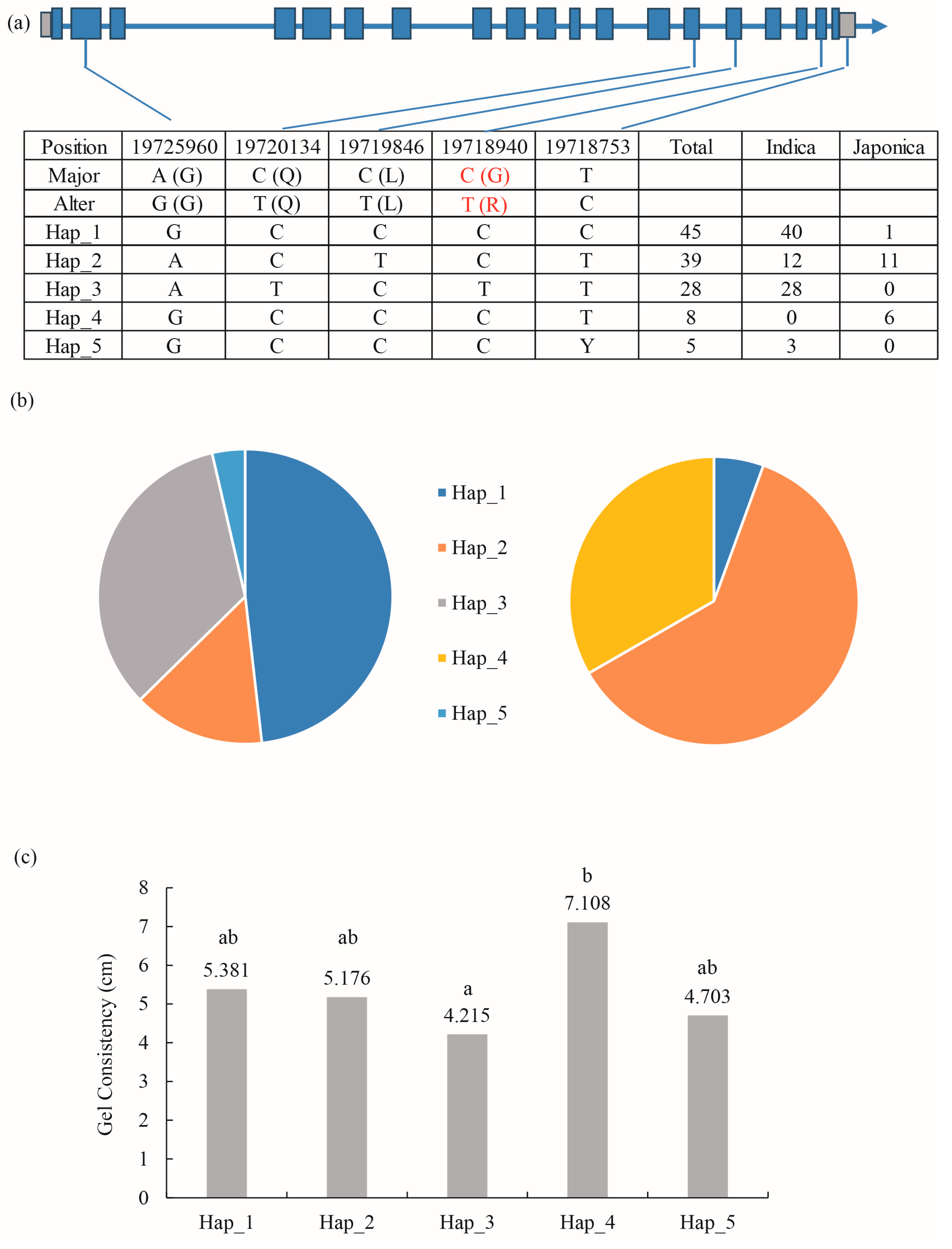A Mutation of cyOsPPDKB Affects Starch Structure and Gel Consistency in Rice
Abstract
:1. Introduction
2. Materials and Methods
2.1. Plant Material and Growth Conditions
2.2. Measurement of Starch Properties
2.2.1. Determination of CEQs
2.2.2. Determination of RVA Profiles
2.2.3. Determination of Starch Swelling in Urea
2.3. Microscopy Analysis
2.3.1. Scanning Electron Microscopy (SEM)
2.3.2. Transmission Electron Microscopy (TEM)
2.3.3. Semi-Thin Sections Microscopy
2.4. Molecular Cloning of FLO4-7
2.5. Haplotypes Analysis of cyOsPPDKB
2.6. Analysis of Homologous Protein Sequence
3. Results
3.1. flo4-7 Exhibits a Floury Endosperm Phenotype
3.2. flo4-7 Shows a Significant Decrease in GC Length
3.3. flo4-7 Exhibits an Increase in Single Starch Granules in the Endosperm
3.4. The flo4-7 Phenotype is Caused by the Mutation of cyOsPPDKB Gene
3.5. A SNP Variation in the 18th Exon of cyOsPPDK is Associated with GC
4. Discussion
4.1. flo4-7 Showed White-Core Endosperm Phenotype
4.2. cyOsPPDKB Provides Energy during Endosperm Development
4.3. cyOsPPDKB can be Applied for Improving the GC Quality of Rice Grains
5. Conclusions
Supplementary Materials
Author Contributions
Funding
Conflicts of Interest
References
- Xing, Z.; Tan, F.; Hua, P.; Sun, L.; Xu, G.; Zhang, Q. Characterization of the main effects, epistatic effects and their environmental interactions of QTLs on the genetic basis of yield traits in rice. Theor. Appl. Genet. 2002, 105, 248–257. [Google Scholar] [CrossRef] [PubMed]
- Qiu, X.J.; Gong, R.; Tan, Y.B.; Yu, S.B. Mapping and characterization of the major quantitative trait locus qSS7 associated with increased length and decreased width of rice seeds. Theor. Appl. Genet. 2012, 125, 1717–1726. [Google Scholar] [CrossRef] [PubMed]
- Zhao, M.C.; Lin, Y.J.; Chen, H. Improving nutritional quality of rice for human health. Theor. Appl. Genet. 2020, 133, 1397–1413. [Google Scholar] [CrossRef] [PubMed]
- Wang, L.Q.; Liu, W.J.; Xu, Y.; He, Y.Q.; Luo, L.J.; Xing, Y.Z.; Xu, C.G.; Zhang, Q.F. Genetic basis of 17 traits and viscosity parameters characterizing the eating and cooking quality of rice grain. Theor. Appl. Genet. 2007, 115, 463–476. [Google Scholar] [CrossRef] [PubMed]
- Xu, Y.; Lin, Q.P.; Li, X.F.; Wang, F.Q.; Chen, Z.H.; Wang, J.; Li, W.Q.; Fan, F.J.; Tao, Y.J.; Jiang, Y.J.; et al. Fine-tuning the amylose content of rice by precise base editing of the Wx gene. Plant Biotechnol. J. 2021, 19, 11–13. [Google Scholar] [CrossRef]
- Zhang, A.P.; Gao, Y.; Li, Y.Y.; Ruan, B.P.; Yang, S.L.; Liu, C.L.; Zhang, B.; Jiang, H.Z.; Fang, G.N.; Ding, S.L.; et al. Genetic analysis for cooking and eating quality of super rice and fine mapping of a novel locus qgc10 for gel consistency. Front. Plant Sci. 2020, 11, 342. [Google Scholar] [CrossRef]
- Wang, Z.Y.; Zheng, F.Q.; Shen, G.Z.; Gao, J.P.; Snustad, D.P.; Li, M.G.; Zhang, J.L.; Hong, M. The amylose content in rice endosperm is related to the post-transcriptional regulation of the waxy gene. Plant J. 1995, 7, 613–622. [Google Scholar] [CrossRef]
- Su, Y.; Rao, Y.C.; Hu, S.K.; Yang, Y.L.; Gao, Z.Y.; Zhang, G.H.; Liu, J.; Hu, J.; Yan, M.X.; Dong, G.J.; et al. Map-based cloning proves qGC-6, a major QTL for gel consistency of japonica/indica cross, responds by Waxy in rice (Oryza sativa L.). Theor. Appl. Genet. 2011, 123, 859–867. [Google Scholar] [CrossRef]
- Zhao, D.S.; Zhang, C.Q.; Li, Q.F.; Liu, Q.Q. Genetic control of grain appearance quality in rice. Biotechnol. Adv. 2022, 60, 108014. [Google Scholar] [CrossRef]
- Tran, N.A.; Daygon, V.D.; Resurreccion, A.P.; Cuevas, R.P.; Corpuz, H.M.; Fitzgerald, M.A. A single nucleotide polymorphism in the Waxy gene explains a significant component of gel consistency. Theor. Appl. Genet. 2011, 123, 519–525. [Google Scholar] [CrossRef]
- Bao, J.S.; Corke, H.; Sun, M. Nucleotide diversity in starch synthase IIa and validation of single nucleotide polymorphisms in relation to starch gelatinization temperature and other physicochemical properties in rice (Oryza sativa L.). Theor. Appl. Genet. 2006, 113, 1171–1183. [Google Scholar] [CrossRef] [PubMed]
- Fitzgerald, M.A.; Martin, M.; Ward, R.M.; Park, W.D.; Shead, H.J. Viscosity of rice flour: A rheological and biological study. J. Agric. Food Chem. 2003, 51, 2295–2299. [Google Scholar] [CrossRef] [PubMed]
- Buenafe, R.; Kumanduri, V.; Sreenivasulu, N. Deploying viscosity and starch polymer properties to predict cooking and eating quality models: A novel breeding tool to predict texture. Carbohydr. Polym. 2021, 260, 117766. [Google Scholar] [CrossRef] [PubMed]
- Pang, Y.L.; Ali, J.; Wang, X.Q.; Franje, N.J.; Revilleza, J.E.; Xu, J.L.; Li, Z.K. Relationship of rice grain amylose, gelatinization temperature and pasting properties for breeding better eating and cooking quality of rice varieties. PLoS ONE 2016, 11, e168483. [Google Scholar] [CrossRef] [PubMed]
- Chun, A.; Song, J.; Kim, K.; Lee, H. Quality of head and chalky rice and deterioration of eating quality by chalky rice. J. Crop Sci. Biotechnol. 2009, 12, 239–244. [Google Scholar] [CrossRef]
- Peng, C.; Wang, Y.H.; Liu, F.; Ren, Y.L.; Zhou, K.N.; Lv, J.; Zheng, M.; Zhao, S.L.; Zhang, L.; Wang, C.; et al. FLOURY ENDOSPERM6 encodes a CBM48 domain-containing protein involved in compound granule formation and starch synthesis in rice endosperm. Plant J. 2014, 77, 917–930. [Google Scholar] [CrossRef]
- Zhao, Q.; Ye, Y.; Han, Z.Y.; Zhou, L.J.; Guan, X.Y.; Pan, G.; Asad, M.A.U.; Cheng, F.M. SSIIIa-RNAi suppression associated changes in rice grain quality and starch biosynthesis metabolism in response to high temperature. Plant Sci. 2020, 294, 110443. [Google Scholar] [CrossRef]
- Cai, Y.; Zhang, W.W.; Fu, Y.S.; Shan, Z.Z.; Xu, J.H.; Wang, P.; Kong, F.; Jin, J.; Yan, H.G.; Ge, X.Y.; et al. Du13 encodes a C2H2 zinc-finger protein that regulates Wxb pre-mRNA splicing and microRNA biogenesis in rice endosperm. Plant Biotechnol. J. 2022, 20, 1387–1401. [Google Scholar] [CrossRef]
- Wang, W.; Wei, X.J.; Jiao, G.A.; Chen, W.Q.; Wu, Y.W.; Sheng, Z.H.; Hu, S.K.; Xie, L.H.; Wang, J.Y.; Tang, S.Q.; et al. GBSS-BINDING PROTEIN, encoding a CBM48 domain-containing protein, affects rice quality and yield. J. Integr. Plant Biol. 2020, 62, 948–966. [Google Scholar] [CrossRef]
- Lei, J.; Teng, X.; Wang, Y.L.; Jiang, X.K.; Zhao, H.H.; Zheng, X.M.; Ren, Y.L.; Dong, H.H.; Wang, Y.L.; Duan, E.C.; et al. Plastidic pyruvate dehydrogenase complex E1 component subunit Alpha1 is involved in galactolipid biosynthesis required for amyloplast development in rice. Plant Biotechnol. J. 2022, 20, 437–453. [Google Scholar] [CrossRef]
- Zhu, X.P.; Teng, X.; Wang, Y.L.; Hao, Y.Y.; Jing, R.N.; Wang, Y.F.; Liu, Y.; Zhu, J.P.; Wu, M.M.; Zhong, M.S.; et al. FLOURY ENDOSPERM11 encoding a plastid heat shock protein 70 is essential for amyloplast development in rice. Plant Sci. 2018, 277, 89–99. [Google Scholar] [CrossRef] [PubMed]
- Swain, A.; Behera, D.; Karmakar, S.; Dash, M.; Dash, B.; Swain, P.; Molla, K.; Baig, M. Morphophysiological alterations in transgenic rice lines expressing PPDK and ME genes from the C4 model Setaria italica. J. Plant Physiol. 2021, 264, 153482. [Google Scholar] [CrossRef] [PubMed]
- Kang, H.; Park, S.; Makoto, M.; An, G. White-core endosperm floury endosperm-4 in rice is generated by knockout mutations in the C4-type pyruvate orthophosphate dikinase gene (OsPPDKB). Plant J. 2005, 42, 901–911. [Google Scholar] [CrossRef] [PubMed]
- Chastain, C.J.; Failing, C.J.; Manandhar, L.; Zimmerman, M.A.; Lakner, M.M.; Nguyen, T.H. Functional evolution C4 pyruvate, orthophosphate dikinase. J. Exp. Bot. 2011, 62, 3083–3091. [Google Scholar] [CrossRef]
- Zhang, L.; Zhao, L.L.; Lin, L.S.; Zhao, L.X.; Liu, Q.Q.; Wei, C.X. A novel mutation of OsPPDKB, encoding pyruvate orthophosphate dikinase, affects metabolism and structure of starch in the rice endosperm. Int. J. Mol. Sci. 2018, 19, 2268. [Google Scholar] [CrossRef]
- Wang, Z.M.; Li, H.X.; Liu, X.F.; He, Y.; Zeng, H.L. Reduction of pyruvate orthophosphate dikinase activity is associated with high temperature-induced chalkiness in rice grains. Plant Physiol. Biochem. 2015, 89, 76–84. [Google Scholar] [CrossRef]
- Wang, H.; Mo, Y.; Im, D.; Jang, S.; Ham, T.; Lee, J.; Jeung, J.; Kwon, S. A new SNP in cyOsPPDK gene is associated with floury endosperm in Suweon 542. Mol. Genet. Genomics 2018, 293, 1151–1158. [Google Scholar] [CrossRef]
- Mo, Y.; Jeung, J.; Shin, Y.; Park, C.; Kang, K.; Kim, B. Agronomic and genetic analysis of Suweon 542, a rice floury mutant line suitable for dry milling. Rice 2013, 6, 37. [Google Scholar] [CrossRef]
- Wang, H.; Ham, T.; Im, D.; Lar, S.; Jang, S.; Lee, J.; Mo, Y.; Jeung, J.; Kim, S.; Kwon, S. A new SNP in rice gene encoding pyruvate phosphate dikinase (PPDK) associated with floury endosperm. Genes 2020, 11, 465. [Google Scholar] [CrossRef]
- Matsuba, S.; Maruyama-Funatsuki, W.; Umemoto, T.; Kato, H.; Kuroki, M.; Yokogami, N.; Ikegaya, T.; Shimizu, H.; Iriki, N. The induced mutant allele flo4-303 confers floury characteristics on the japonica rice cultivar ‘Hoshinoko’. Breed. Sci. 2022, 72, 383–388. [Google Scholar] [CrossRef]
- Ha, S.-K.; Lee, H.-S.; Lee, S.Y.; Lee, C.-M.; Mo, Y.; Jeung, J.-U. Characterization of flo4-6, a novel cyOsPPDKB allele conferring floury endosperm characteristics suitable for dry-milled rice flour production. Agronomy 2023, 13, 1306. [Google Scholar] [CrossRef]
- Wu, M.M.; Cai, M.H.; Zhai, R.R.; Ye, J.; Zhu, G.F.; Yu, F.M.; Ye, S.H.; Zhang, X.M. A mitochondrion-associated PPR protein, WBG1, regulates grain chalkiness in rice. Front. Plant Sci. 2023, 14, 1136849. [Google Scholar] [CrossRef] [PubMed]
- Yang, J.; Luo, D.; Yang, B.; Frommer, W.B.; Eom, J.S. SWEET11 and 15 as key players in seed filling in rice. New Phytol. 2018, 218, 604–615. [Google Scholar] [CrossRef] [PubMed]
- Cai, Y.C.; Li, S.F.; Jiao, G.A.; Sheng, Z.H.; Wu, Y.W.; Shao, G.N.; Xie, L.H.; Peng, C.; Xu, J.F.; Tang, S.Q.; et al. OsPK2 encodes a plastidic pyruvate kinase involved in rice endosperm starch synthesis, compound granule formation and grain filling. Plant Biotechnol. J. 2018, 16, 1878–1891. [Google Scholar] [CrossRef] [PubMed]
- Hu, L.; Tu, B.; Yang, W.; Yuan, H.; Li, J.L.; Guo, L.N.; Zheng, L.; Chen, W.L.; Zhu, X.B.; Wang, Y.P.; et al. Mitochondria-associated pyruvate kinase complexes regulate grain filling in rice. Plant Physiol. 2020, 183, 1073–1087. [Google Scholar] [CrossRef]
- Wu, M.W.; Zhao, H.; Zhang, J.D.; Guo, L.; Liu, C.M. RADICLELESS 1 (RL1)-mediated nad4 intron 1 splicing is crucial for embryo and endosperm development in rice (Oryza sativa L.). Biochem. Biophys. Res. Commun. 2020, 523, 220–225. [Google Scholar] [CrossRef]
- Nishi, A.; Nakamura, Y.; Tanaka, N.; Satoh, H. Biochemical and genetic analysis of the effects of amylose-extender mutation in rice endosperm. Plant Physiol. 2001, 127, 459–472. [Google Scholar] [CrossRef]
- Yan, C.J.; Tian, Z.X.; Fang, Y.W.; Yang, Y.C.; Li, J.; Zeng, S.Y.; Gu, S.L.; Xu, C.W.; Tang, S.Z.; Gu, M.H. Genetic analysis of starch paste viscosity parameters in glutinous rice (Oryza sativa L.). Theor. Appl. Genet. 2011, 122, 63–76. [Google Scholar] [CrossRef]






Disclaimer/Publisher’s Note: The statements, opinions and data contained in all publications are solely those of the individual author(s) and contributor(s) and not of MDPI and/or the editor(s). MDPI and/or the editor(s) disclaim responsibility for any injury to people or property resulting from any ideas, methods, instructions or products referred to in the content. |
© 2023 by the authors. Licensee MDPI, Basel, Switzerland. This article is an open access article distributed under the terms and conditions of the Creative Commons Attribution (CC BY) license (https://creativecommons.org/licenses/by/4.0/).
Share and Cite
Gao, Z.; Li, C.; Huang, F.; Xu, J.; He, Y.; Dan, Y.; Hao, Y.; Tian, Z. A Mutation of cyOsPPDKB Affects Starch Structure and Gel Consistency in Rice. Agronomy 2023, 13, 2759. https://doi.org/10.3390/agronomy13112759
Gao Z, Li C, Huang F, Xu J, He Y, Dan Y, Hao Y, Tian Z. A Mutation of cyOsPPDKB Affects Starch Structure and Gel Consistency in Rice. Agronomy. 2023; 13(11):2759. https://doi.org/10.3390/agronomy13112759
Chicago/Turabian StyleGao, Zhennan, Chunshou Li, Fudeng Huang, Junfeng Xu, Yong He, Yuqing Dan, Yuanyuan Hao, and Zhihong Tian. 2023. "A Mutation of cyOsPPDKB Affects Starch Structure and Gel Consistency in Rice" Agronomy 13, no. 11: 2759. https://doi.org/10.3390/agronomy13112759



